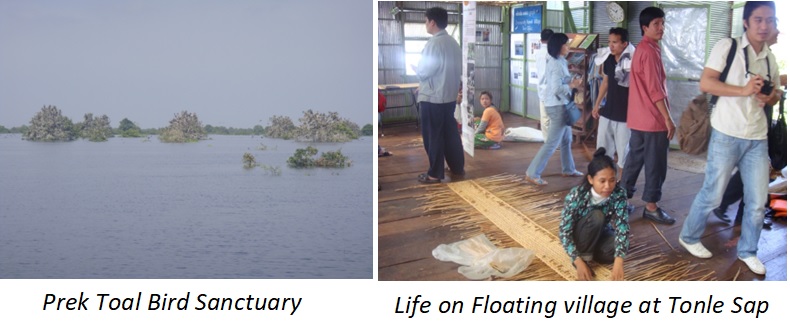Tonle Sap Lake (The Great Lake)
The great Tonle Sap lake is the richest fresh water fishing ground in the world, a national treasure producing an ever-changing landscape. The communities that live around the margins of the lake cope with huge seasonal variations in water levels by building their homes on floating bamboo rafts or 30ft stilts. It is well worth the extra effort to get away from the touristy village of Chong Kneas to the more genuine stilted villages – Kompong Khleang or Kompong Phluk (dependent on water levels) – for an understanding of contemporary lake life.
The Tonle Sap Lake, along with the Tonle Sap River, forms a unique hydrological system as well as an enormously diverse aquatic ecosystem. Tonle Sap Lake acts as an extremely important fish breeding ground and flood leveler of the Mekong River system. This lake’s importance reaches far beyond Cambodia.
Tonle Sap Lake Hydrology Cycle and Seasonal Biodiversity
The Mekong River is a transboundary river flowing through six countries with the total annual runoff of 475,000 million cubic meters and the total length of over 4,800 km, which makes it the 12th longest river in the world. After passing the last rapids at the northern part of Cambodia, the Mekong traverses a series of levees and empties into an extended floodplain.
Once the Mekong River flows down to Phnom Penh it is joined by the 120-kilometer long Tonle Sap River that links the Tonle Sap Lake to the Mekong River. Here the Mekong creates a wonder of the World. During the flood season (June to October) when the water level in the Mekong rises, it forces the Tonle Sap River to flow backwards into the Tonle Sap Great Lake.
The water flow from the Mekong to the Tonle Sap Lake occurs during the flood season when the rising water level of the Mekong River forces the Tonle Sap River to reverse its flow into the Tonle Sap Lake. The incoming water causes intensive flooding that extends the Lake over vast floodplains consisting mainly of forests, shrubs and rice field.
Periodic flooding that carries sediment-rich water from the Mekong to the Lake combined with the area’s high biodiversity are the main reasons for the development of a unique and rich ecosystem. The Tonle Sap ecosystem is one of the most productive inland waters and one of the most fish-abundant lakes in the World where flooded forests and shrubs offer shelter and breeding grounds for fish and other aquatic animals. The total fish production from the Lake is about 230,000 tons/year, which forms almost half of Cambodia’s total fish production.
Migration of different fish species between the Tonle Sap Lake and the Mekong River is extensive and diverse. During the inflow from approximately June to September there is mostly a passive migration of eggs, fry and fish to the Tonle Sap Lake and its floodplains. Later, fish follow the receding floodwater back to the Lake and finally back to the Mekong River.
Prek Toal Bird Sanctuary
The Tonle Sap Biosphere Reserve (TSBR), covering all of the lake plus a significant part of the floodplain, and divided into three zones: core zones, buffer zone and transition zone.
In the transition zone, sustainable natural resource management practices are to be established, while the buffer zone is an area where activities are to be compatible with conservation, in order to protect the core zones.
The three core zones are Prek Toal for bird colonies (21,342 ha), Boeng Chhmar as bird feeding areas (14,560 ha) and Stung Sen as unique gallery forests (6,355 ha).
Prek Toal is located at the Southwest corner of the lake. Access to the area is only possible by boats that takes one hour from Chong Kneas, Siem Reap province.
Between March and May, at minimum water level, the water retreats from the floodplain of inundated forest, leaving many small isolated deep pools of water. At this time, the marsh and swamp, which appears by the lakeshore at the fringe of flooded forest serve as feeding grounds for large colonies of waterbirds.
The area is found to accommodate large population of waterbirds ranging from the World’s most endangered species to vulnerable threatened and to common species. Parr et al, (1996) identified three endangered species, Spot-billed Pelican (Pelicanus philippensis), Greater Adjutant (Leptoptilus dubius) and White-winged Duck (Cairina scutulata); two vulnerable threatened species, Milky Stork (Mycteria cinerea) and Lesser Adjutant (Leptoptilus javanicus); and five near-threatened species, Oriental Darter (Anhinga melanogaster), Painted Stork (Mycteria leucocephala), Asian Openbill (Anastomas oscitans), Black-headed Ibis (Threskiornis melanocephalus), and Greyheaded Fish-Eagle (Ichthyophaga ichthyaetus).
Take the opportunity to pause at the stilted houses to learn how a subsistence fishing family lives, before continuing by boat along the margins of the lake.
Note: For this visiting option lunch will be arranged by ICERD Organizer (Lunch Box or at the Floating Village)

